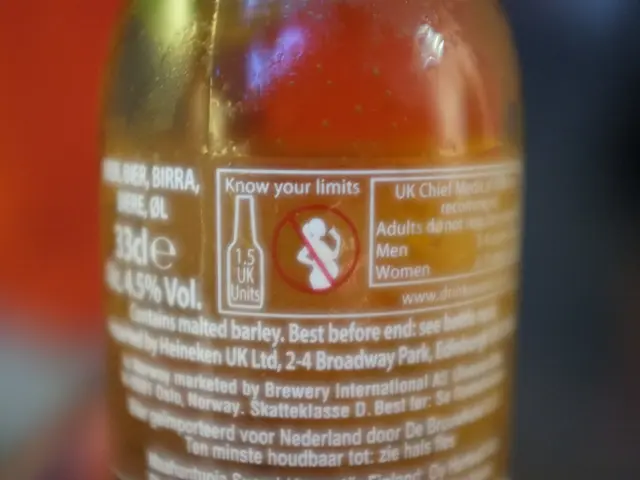Potential Hazards and Safety Measures when Combining Cocaine and Alcohol
The dangerous combination of cocaine and alcohol presents significant health risks, many of which are unique to this drug duo. This article aims to shed light on the immediate and long-term effects of this dangerous mix.
When cocaine and alcohol are consumed together, a new compound called cocaethylene is formed in the liver [1][3]. This metabolite, which exhibits stimulant effects, is 30% more toxic than cocaine alone [3]. The presence of cocaethylene increases the risk of sudden death by 18-25 times compared to using cocaine by itself [1][3]. It is also associated with a higher incidence of myocardial injury and cardiac arrest [3].
The co-use of these substances markedly elevates the risk of atherosclerotic cardiovascular disease, with the risk increasing up to 9 times when combined with other substances [1]. Recent research highlights a sharp rise in stimulant-involved cardiovascular mortality, with alcohol accelerating cocaine's toxicity to the heart [5]. Chronic use can lead to dilated cardiomyopathy, atrial fibrillation, left ventricular dysfunction, and increased risk of heart failure [5].
In the short term, the combination of cocaine and alcohol increases heart rate and blood pressure, raising the risk of heart attack and stroke [1][3]. The risk of sudden death is also significantly higher due to cocaethylene's enhanced toxicity [1][3]. There is also a potential for severe arrhythmias, which can lead to cardiac arrest [3].
Long-term effects include permanent damage to the heart and vascular system from repeated exposure to cocaethylene and the combined effects of both drugs [1][3][5]. The combination also increases the incidence of substance use disorders, with the combination sometimes leading to more compulsive use patterns [1]. Over time, irreversible organ damage and increased mortality are also likely [1][3].
Other considerations include the masking of intoxication, where the stimulating effects of cocaine may lead users to consume more alcohol than they otherwise would, increasing the risk of alcohol poisoning. The liver is also strained by processing both drugs simultaneously, increasing the risk of liver damage. The effects of cocaethylene can vary widely between individuals, making the combination especially unpredictable and dangerous [3].
| Risk/Side Effect | Description | |------------------------------------|------------------------------------------------------------------------------| | Cocaethylene formation | 18–25x increased risk of sudden death compared to cocaine alone [1][3] | | Cardiac events | Myocardial injury, cardiac arrest, arrhythmias, heart attack [1][3][5] | | Cardiovascular disease | Up to 9x increased risk with poly-substance use [1] | | Organ damage | Heart, liver, and vascular system at risk [1][3][5] | | Substance use disorder | Higher incidence with combined use [1] |
In conclusion, the combination of cocaine and alcohol is one of the most hazardous forms of polysubstance use. The risks far exceed those of either drug used alone, making this combination exceptionally dangerous. If you suspect an overdose of cocaine and alcohol, immediate medical care is required. Additionally, anyone who has or knows someone who has a drug addiction may wish to consider contacting a support network.
- The science behind it reveals that when alcohol and drugs like cocaine are combined, a compound called cocaethylene is formed in the liver [1][3].
- This metabolite, cocaethylene, is 30% more toxic than cocaine alone and increases the risk of sudden death by 18-25 times compared to using cocaine by itself [1][3].
- The co-use of these substances significantly elevates the risk of atherosclerotic cardiovascular disease, with the risk increasing up to 9 times when combined with other substances [1].
- The short-term effects include a surge in heart rate and blood pressure, raising the risk of heart attack and stroke [1][3].
- The long-term effects include permanent damage to the heart and vascular system from repeated exposure to cocaethylene and the combined effects of both drugs [1][3][5].
- The combination also increases the incidence of substance use disorders, with the combination sometimes leading to more compulsive use patterns [1].
- Other risks include masked intoxication, where stimulating effects of cocaine may lead users to consume more alcohol, increasing the risk of alcohol poisoning. The liver is also strained by processing both drugs simultaneously, increasing the risk of liver damage.
- The effects of cocaethylene can vary widely between individuals, making the combination especially unpredictable and dangerous [3].
- In conclusion, the combination of cocaine and alcohol is one of the most hazardous forms of polysubstance use. The risks far exceed those of either drug used alone, making this combination exceptionally dangerous.
- In case of an overdose of cocaine and alcohol, immediate medical care is required.
- Anyone who has or knows someone who has a drug addiction may wish to consider contacting a support network. Additionally, exploring health-and-wellness topics like fitness-and-exercise, mental-health, skin-care, nutrition, and therapies-and-treatments can provide alternative pathways for overall wellness.
- On a different note, social media, entertainment, pop-culture, and sci-fi-and-fantasy can offer ways to manage stress and connect with others, but it's essential to maintain a balanced approach and be mindful of potential triggers. Skin-conditions and eye-health should not be overlooked, as they can provide vital indicators of overall health status.






